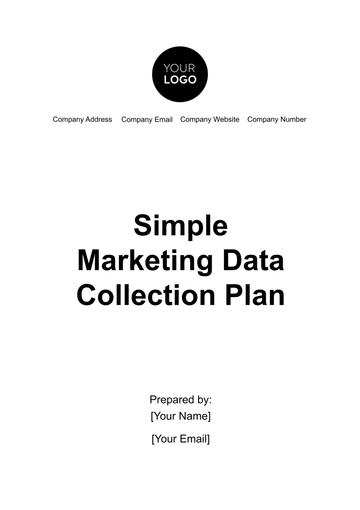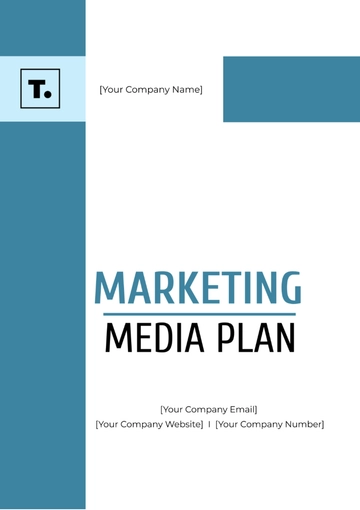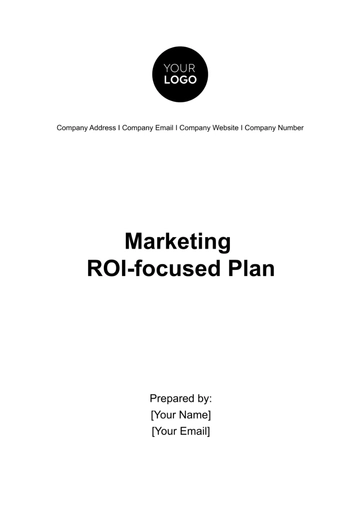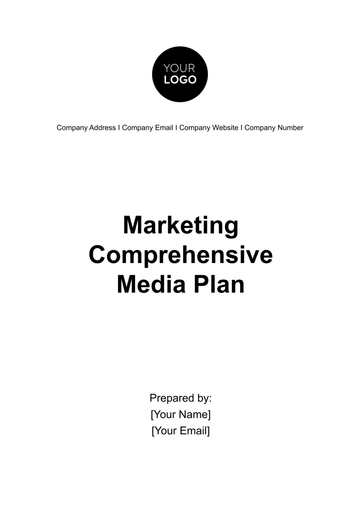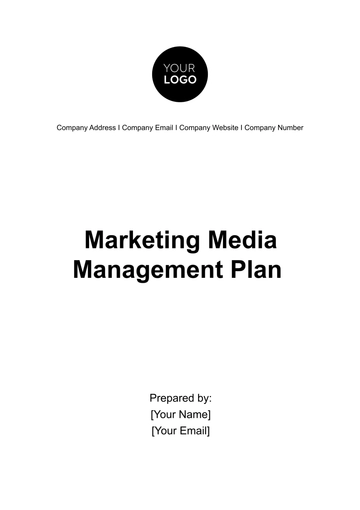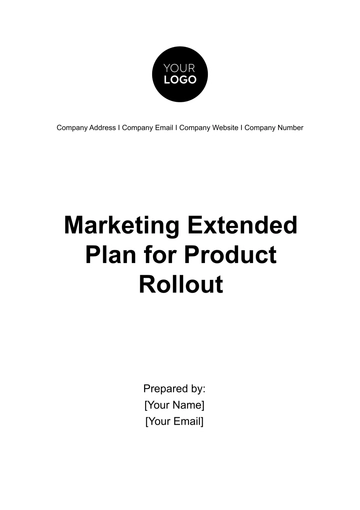Free Multichannel Marketing Strategy Plan

Executive Summary
A. Overview
The Executive Summary provides a high-level view of the Multichannel Marketing Strategy Plan for [Your Company Name]. It serves as an introduction to the document, summarizing key points for a quick understanding.
[Your Company Name] is a leading company in the consumer electronics industry, specializing in innovative and high-quality electronic products. This Multichannel Marketing Strategy Plan outlines our approach to leveraging various marketing channels to meet our marketing objectives.
B. Key Objectives
Our multichannel marketing strategy focuses on achieving four key objectives:
Increase Brand Awareness
Our primary goal is to increase brand awareness by 30% in the next year. This will be achieved through strategic marketing efforts that highlight our unique value propositions and engage our target audience.
Boost Lead Generation
We aim to generate 20% more leads through our multichannel marketing efforts. This involves creating engaging content, optimizing our website, and targeting the right audience.
Drive Sales Conversions
To drive sales conversions, we plan to achieve a 15% growth in sales. This will involve optimizing our e-commerce platforms, refining the customer journey, and enhancing product visibility.
Enhance Customer Loyalty
Customer loyalty is crucial to our long-term success. We aim to improve customer retention and loyalty by 25% through personalized communication, exceptional customer service, and loyalty programs.
C. Target Audience
Our multichannel marketing efforts will be targeted at tech-savvy consumers aged 18 to 45. These individuals are passionate about the latest technology trends, and they value innovation and quality. Understanding their demographics, interests, and pain points is crucial to tailoring our marketing campaigns effectively.
D. Metrics for Success
To measure the success of our multichannel marketing strategy, we will track the following key performance indicators (KPIs):
Brand Awareness: This will be measured by analyzing website traffic and social media reach to ensure our brand is gaining prominence.
Lead Generation: We will track lead generation through form submissions, contact inquiries, and the growth of our email list.
Sales Conversions: Sales conversions will be tracked through e-commerce data, allowing us to evaluate the effectiveness of our strategies.
Customer Loyalty: Customer loyalty will be assessed through customer surveys, repeat purchase rates, and Net Promoter Scores (NPS).
Company Overview
A. Introduction
[Your Company Name] is a renowned consumer electronics company known for its relentless pursuit of innovation and quality. We take pride in our mission to provide cutting-edge technology solutions that enhance people's lives.
B. [Your Company Name] Background
Established in 2005, [Your Company Name] has a rich history of innovation and excellence in the electronics industry. Our core values revolve around integrity, customer-centricity, and a commitment to delivering products that make a difference in the lives of our customers.
C. Industry Analysis
In 2050, the consumer electronics industry is experiencing rapid evolution driven by advances in AI, IoT, and sustainable technologies. The demand for smart, eco-friendly devices is on the rise, presenting a significant opportunity for growth.
Additionally, the growing emphasis on e-commerce and digital marketing is reshaping the way consumers engage with electronics brands.
D. Competitive Analysis
To succeed in our industry, it's imperative to have a comprehensive understanding of our competition. We have identified key competitors in our space, including [Competitor 1] and [Competitor 2]. Analyzing their strengths and weaknesses, as well as their market positioning, will inform our strategy.
Our detailed competitive analysis reveals insights into how we can differentiate ourselves. For instance, while [Competitor 1] excels in product innovation, we can focus on exceptional customer service to set us apart. By understanding our competition, we can tailor our marketing messages to highlight our unique strengths.
Situation Analysis
A. Market Trends
In 2050, the consumer electronics industry is experiencing several key trends that influence our marketing strategy:
Market Trends | Impact on Strategy |
Sustainability Focus | Emphasizing eco-friendly products and practices. |
AI and IoT Integration | Creating smart devices and leveraging AI in marketing. |
E-commerce Dominance | Shifting focus toward online sales and digital marketing. |
Health and Wellness Tech | Incorporating health-related features in products. |
B. SWOT Analysis
Strengths:
Strong brand reputation for innovation and quality.
A diverse range of high-tech products.
A loyal customer base with repeat purchases.
Weaknesses:
High competition in the consumer electronics market.
Dependence on third-party retailers for distribution.
Limited presence in emerging markets.
Opportunities:
Growing demand for eco-friendly and sustainable electronics.
Expansion into emerging markets in Asia.
Leveraging AI for personalized marketing.
Threats:
Rapid technological advancements, requiring constant innovation.
Intense competition from tech giants.
Economic fluctuations affecting consumer spending.
C. Customer Behavior Analysis
Understanding our target audience's behavior is crucial. Our research indicates that our customers are tech-savvy and prefer researching products online before making a purchase. They value product reviews, personalized recommendations, and easy online purchasing.
D. Data and Analytics
We will leverage data analytics tools such as Google Analytics, customer relationship management (CRM) software, and social media analytics to gather data on customer behavior, engagement, and conversion rates. This data will guide our decision-making process and allow us to make data-driven marketing decisions.
Multichannel Marketing Goals
A. Goal 1: Increase Brand Awareness
To achieve a 30% increase in brand awareness, we will implement a comprehensive content marketing strategy, including blog posts, video content, and infographics. We will collaborate with influencers in the tech industry to amplify our reach and gain more exposure. Our KPIs for this goal are as follows:
KPI | Target Value |
Website Traffic | 50% growth |
Social Media Reach | 40% growth |
B. Goal 2: Boost Lead Generation
To generate 20% more leads, we will create highly targeted landing pages for our products, offering exclusive discounts in exchange for email subscriptions. We will also implement robust email marketing campaigns and integrate chatbots on our website. KPIs for this goal include:
KPI | Target Value |
Lead Generation Rate | 20% increase |
Email List Growth | 30% increase |
C. Goal 3: Drive Sales Conversions
To achieve a 15% growth in sales conversions, we will focus on improving user experience on our e-commerce platform. We will use retargeting ads, implement one-click purchasing options, and provide personalized product recommendations. KPIs for this goal include:
KPI | Target Value |
Conversion Rate | 15% increase |
Average Order Value | 10% increase |
D. Goal 4: Enhance Customer Loyalty
Enhancing customer loyalty by 25% is a priority. We will implement a customer loyalty program, offer extended warranties, and provide excellent post-purchase support. KPIs for this goal are as follows:
KPI | Target Value |
Customer Retention Rate | 25% increase |
Net Promoter Score (NPS) | 8 or above |
We'll continually monitor these KPIs using our analytics tools to ensure we are on track to meet our objectives.
Multichannel Marketing Channels
Our multichannel marketing strategy will encompass both online and offline channels, ensuring a comprehensive approach to reach and engage our target audience effectively.
A. Online Channels
Website
Our website, www.abc-electronics.com, will serve as the central hub for our digital presence. It will be optimized for user experience and loaded with informative content about our products. The website will feature:
Product pages with detailed descriptions and high-quality images.
Customer reviews and ratings for social proof.
A blog section for informative articles on tech trends.
An e-commerce platform with secure payment options.
Social Media
We will leverage popular social media platforms, including Facebook, Twitter, Instagram, and LinkedIn, to connect with our audience. Our content strategy will include:
Regular posts showcasing our products.
Interactive content such as polls, quizzes, and giveaways.
Collaborations with influencers and tech enthusiasts.
Customer support via social channels.
Email Marketing
Our email marketing strategy will involve segmented email lists to provide personalized content to subscribers. We will send:
Product updates and promotions.
Educational content and tutorials.
Exclusive discounts and offers.
Regular newsletters with tech insights.
Paid Advertising
To increase brand visibility and drive sales, we will invest in paid advertising on platforms such as Google Ads and Facebook Ads. Our approach includes:
Targeted ads based on user behavior and interests.
Remarketing ads to re-engage potential customers.
A/B testing for ad optimization.
Budget allocation based on ROI.
B. Offline Channels
Print Media
We will run print campaigns in tech magazines and relevant publications. Print materials will include:
Full-page advertisements.
Product brochures with QR codes linking to our website.
Coupons for in-store or online discounts.
Event invitations.
Events & Sponsorships
Participation in tech expos and sponsorships of tech events will enhance our offline presence. Our strategy includes:
Booths with live product demonstrations.
Sponsorship of keynotes and tech talks.
Product giveaways and exclusive event discounts.
Collecting customer data for future marketing.
Direct Mail
For a personalized touch, we will employ direct mail campaigns to target specific customer segments. Our direct mail approach will include:
Customized postcards or catalogs.
Exclusive offers and discounts.
Personalized greetings and recommendations.
Call-to-action for online engagement.
Content Strategy
A. Content Creation
Our content creation strategy will focus on producing high-quality and engaging content across various channels. Content types will include:
Blog Posts: Regular articles on tech trends, product reviews, and how-to guides.
Videos: Product demos, tutorials, and customer testimonials.
Infographics: Visual representations of data and information.
Podcasts: Tech-related podcasts featuring industry experts.
Interactive Content: Polls, quizzes, and contests to engage the audience.
B. Content Distribution
We will ensure our content is distributed effectively to reach our target audience. This will involve:
Optimizing content for search engines (SEO).
Sharing content across social media platforms.
Promoting content through email newsletters.
Collaborating with influencers to share our content.
Utilizing paid advertising to boost content visibility.
C. Content Calendar
A well-structured content calendar will keep our content creation and distribution organized. It will include:
Publication dates for blog posts, videos, and podcasts.
Social media posting schedules.
Email campaign schedules.
Launch dates for major campaigns and promotions.
D. SEO Strategy
Search engine optimization (SEO) is a vital aspect of our content strategy. We will optimize our website and content to rank higher on search engines, including:
Keyword research to target relevant search terms.
On-page optimization for website content.
Building high-quality backlinks.
Monitoring and adjusting SEO strategies based on performance.
E. Social Media Content
Our social media content will be diverse and engaging, including:
Regular product showcases with captivating visuals.
Interactive content like polls and Q&A sessions.
Customer testimonials and success stories.
Behind-the-scenes glimpses of our team and product development.
Team and Responsibilities
A. Marketing Team Structure
Our marketing team is organized to ensure efficient execution of our multichannel marketing strategy. The team structure includes the following key roles:
Name | Role | Responsibility |
[Your Name], [Your Company Email] | Marketing Director | Oversees the entire marketing strategy and implementation, ensuring alignment with the company's goals. |
[Name], [Email] | Digital Marketing Manager | Manages online channels, including the website, social media, email marketing, and paid advertising. |
[Name], [Email] | Content Manager | Responsible for content creation and distribution, including blog posts, videos, and other digital content. |
[Name], [Email] | SEO Specialist | Focuses on optimizing our website and content for search engines. |
[Name], [Email] | Social Media Coordinator | Manages and grows our presence on social media platforms. |
[Name], [Email] | Email Marketing Specialist | Manages our email campaigns and subscriber lists. |
[Name], [Email] | Data Analyst | Collects and analyzes data to provide insights for continuous optimization. |
[Name], [Email] | Event Coordinator | Handles event planning and sponsorship activities. |
Conclusion
In conclusion, this Multichannel Marketing Strategy Plan for [Your Company Name] is designed to propel our brand to new heights in 2050 and beyond. With a focus on increasing brand awareness, boosting lead generation, driving sales conversions, and enhancing customer loyalty, we are confident in our ability to thrive in the dynamic consumer electronics industry.
Our thorough situation analysis has provided insights into market trends, our competitive position, and customer behavior, enabling us to tailor our strategy effectively. We are committed to monitoring key performance indicators closely and optimizing our approach based on data-driven insights.
- 100% Customizable, free editor
- Access 1 Million+ Templates, photo’s & graphics
- Download or share as a template
- Click and replace photos, graphics, text, backgrounds
- Resize, crop, AI write & more
- Access advanced editor
Elevate your marketing game with Template.net's Multichannel Marketing Strategy Plan Template. Crafted for versatility, it's fully editable and customizable, ensuring your strategy reflects your unique brand vision. Seamlessly adjust in our Ai Editor Tool, optimizing every channel for maximum impact. Transform your approach and dominate the market effortlessly.
You may also like
- Finance Plan
- Construction Plan
- Sales Plan
- Development Plan
- Career Plan
- Budget Plan
- HR Plan
- Education Plan
- Transition Plan
- Work Plan
- Training Plan
- Communication Plan
- Operation Plan
- Health And Safety Plan
- Strategy Plan
- Professional Development Plan
- Advertising Plan
- Risk Management Plan
- Restaurant Plan
- School Plan
- Nursing Home Patient Care Plan
- Nursing Care Plan
- Plan Event
- Startup Plan
- Social Media Plan
- Staffing Plan
- Annual Plan
- Content Plan
- Payment Plan
- Implementation Plan
- Hotel Plan
- Workout Plan
- Accounting Plan
- Campaign Plan
- Essay Plan
- 30 60 90 Day Plan
- Research Plan
- Recruitment Plan
- 90 Day Plan
- Quarterly Plan
- Emergency Plan
- 5 Year Plan
- Gym Plan
- Personal Plan
- IT and Software Plan
- Treatment Plan
- Real Estate Plan
- Law Firm Plan
- Healthcare Plan
- Improvement Plan
- Media Plan
- 5 Year Business Plan
- Learning Plan
- Marketing Campaign Plan
- Travel Agency Plan
- Cleaning Services Plan
- Interior Design Plan
- Performance Plan
- PR Plan
- Birth Plan
- Life Plan
- SEO Plan
- Disaster Recovery Plan
- Continuity Plan
- Launch Plan
- Legal Plan
- Behavior Plan
- Performance Improvement Plan
- Salon Plan
- Security Plan
- Security Management Plan
- Employee Development Plan
- Quality Plan
- Service Improvement Plan
- Growth Plan
- Incident Response Plan
- Basketball Plan
- Emergency Action Plan
- Product Launch Plan
- Spa Plan
- Employee Training Plan
- Data Analysis Plan
- Employee Action Plan
- Territory Plan
- Audit Plan
- Classroom Plan
- Activity Plan
- Parenting Plan
- Care Plan
- Project Execution Plan
- Exercise Plan
- Internship Plan
- Software Development Plan
- Continuous Improvement Plan
- Leave Plan
- 90 Day Sales Plan
- Advertising Agency Plan
- Employee Transition Plan
- Smart Action Plan
- Workplace Safety Plan
- Behavior Change Plan
- Contingency Plan
- Continuity of Operations Plan
- Health Plan
- Quality Control Plan
- Self Plan
- Sports Development Plan
- Change Management Plan
- Ecommerce Plan
- Personal Financial Plan
- Process Improvement Plan
- 30-60-90 Day Sales Plan
- Crisis Management Plan
- Engagement Plan
- Execution Plan
- Pandemic Plan
- Quality Assurance Plan
- Service Continuity Plan
- Agile Project Plan
- Fundraising Plan
- Job Transition Plan
- Asset Maintenance Plan
- Maintenance Plan
- Software Test Plan
- Staff Training and Development Plan
- 3 Year Plan
- Brand Activation Plan
- Release Plan
- Resource Plan
- Risk Mitigation Plan
- Teacher Plan
- 30 60 90 Day Plan for New Manager
- Food Safety Plan
- Food Truck Plan
- Hiring Plan
- Quality Management Plan
- Wellness Plan
- Behavior Intervention Plan
- Bonus Plan
- Investment Plan
- Maternity Leave Plan
- Pandemic Response Plan
- Succession Planning
- Coaching Plan
- Configuration Management Plan
- Remote Work Plan
- Self Care Plan
- Teaching Plan
- 100-Day Plan
- HACCP Plan
- Student Plan
- Sustainability Plan
- 30 60 90 Day Plan for Interview
- Access Plan
- Site Specific Safety Plan







